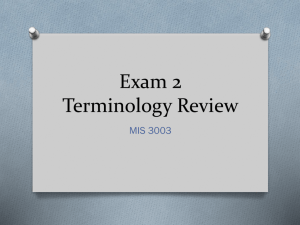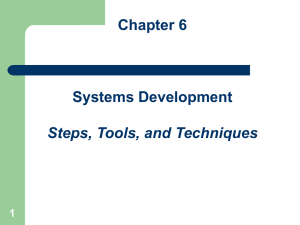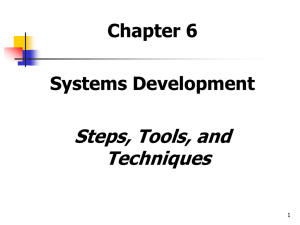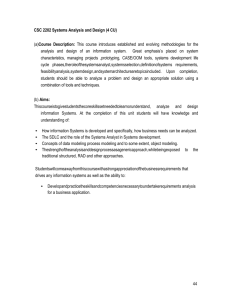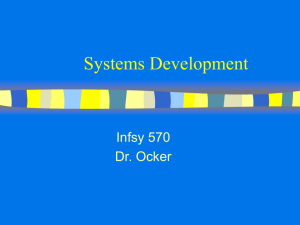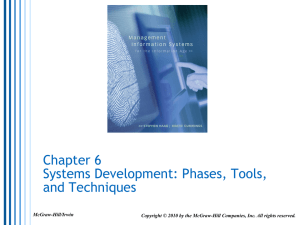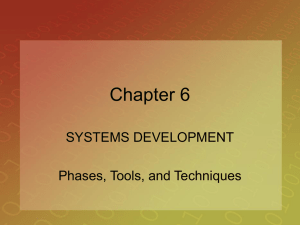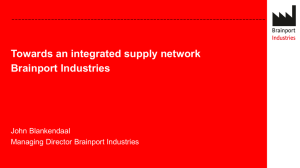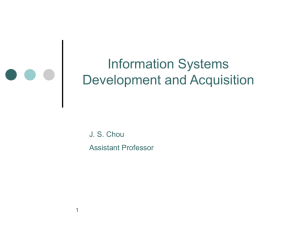Practice Questions Chapter 6: Systems Development Chapter 7
advertisement
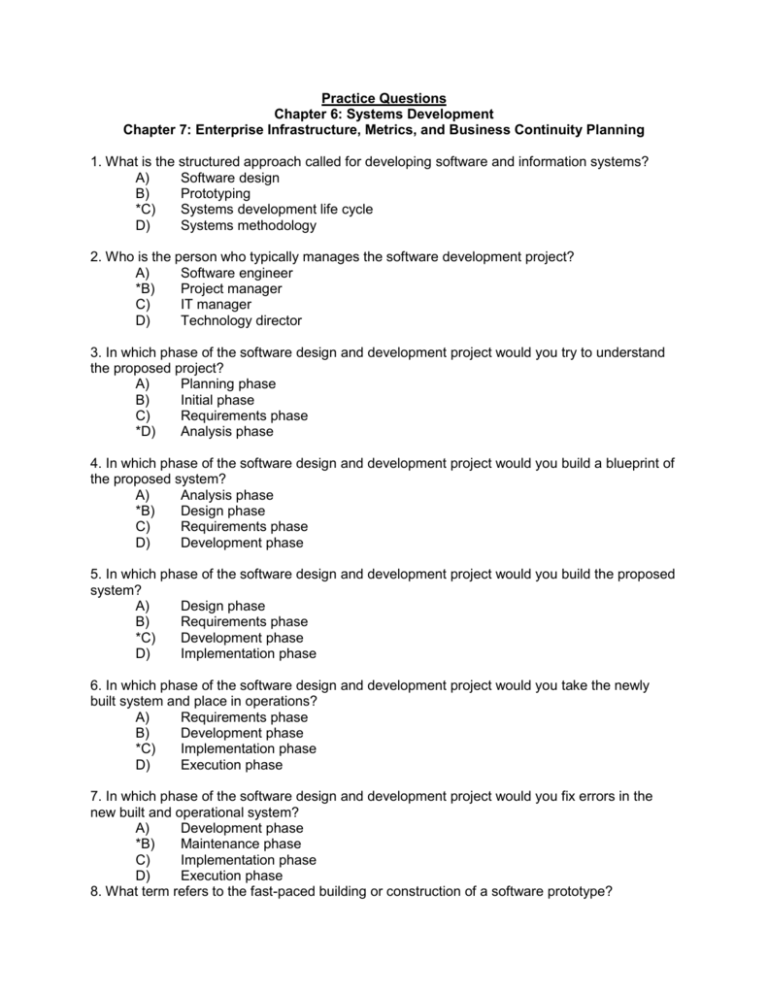
Practice Questions Chapter 6: Systems Development Chapter 7: Enterprise Infrastructure, Metrics, and Business Continuity Planning 1. What is the structured approach called for developing software and information systems? A) Software design B) Prototyping *C) Systems development life cycle D) Systems methodology 2. Who is the person who typically manages the software development project? A) Software engineer *B) Project manager C) IT manager D) Technology director 3. In which phase of the software design and development project would you try to understand the proposed project? A) Planning phase B) Initial phase C) Requirements phase *D) Analysis phase 4. In which phase of the software design and development project would you build a blueprint of the proposed system? A) Analysis phase *B) Design phase C) Requirements phase D) Development phase 5. In which phase of the software design and development project would you build the proposed system? A) Design phase B) Requirements phase *C) Development phase D) Implementation phase 6. In which phase of the software design and development project would you take the newly built system and place in operations? A) Requirements phase B) Development phase *C) Implementation phase D) Execution phase 7. In which phase of the software design and development project would you fix errors in the new built and operational system? A) Development phase *B) Maintenance phase C) Implementation phase D) Execution phase 8. What term refers to the fast-paced building or construction of a software prototype? *A) B) C) D) Rapid application development (RAD) Rapid agility programming (RAP) Speed programming Express development (ED) 9. What type of software design and development methodology does Microsoft Corporation employ? A) Rapid application development *B) Extreme programming C) Speed programming D) Express development 10. What term refers to the end user developing software without the assistance of IT? A) User development B) In-sourcing C) Self service *D) Selfsourcing 11. If you the end user participated on a team responsible for defining a prototype for a proposed application, what phase in the SDLC would you be working in? *A) Analysis B) Design C) Planning D) Development 12. Which of the following occurs when developers and end users add extra features that were not part of the initial requirements? A) Scope creep *B) Feature creep C) Milestone D) Rolling stone 13. In which phase does the project team move from the physical design to the physical implementation? A) Implementation B) Testing *C) Development D) Transformation 14. Which of the following methodologies emphasizes extensive user involvement in the rapid and evolutionary construction of working prototypes? A) SDLC B) Waterfall modeling C) Project scoping *D) Rapid application development (RAD) 15. Which of the following IT tools are often used for selfsourcing? A) Spreadsheets B) Database management C) Web development *D) Spreadsheets, database management and Web development are all common selfsourcing tools 16. Which of the following is not an advantage of selfsourcing? A) It increases the speed of systems development *B) It focuses on important and unique core competencies C) It increases end user participation and sense of ownership D) It improves requirements determination 17. Which of the following is true with regards to prototyping? A) Prototyping is an iterative process B) Prototypes are built from business requirements C) End users review prototypes and suggest further changes which will then be used to refine the prototype *D) Each of these items is true of prototyping 18. Which of the following is an advantage of prototyping? A) Encourages active user participation B) Helps resolve discrepancies among end users C) Gives users a feel for the final system *D) Each of these items is an advantage of prototyping 19. Which SDLC phase is performed with both internal software development and outsourcing? A) Design B) Development C) Maintenance *D) Analysis 20. What is the trend called when a U.S. company outsources IT functions to other countries? A) Foreign outsourcing *B) Offshore outsourcing C) External outsourcing D) Outer outsourcing 21. What type of information systems environment reuses self-contained blocks of code in its systems? A) Modular systems B) Block based coding C) Component programming *D) Service-oriented architecture 22. What terms refers to the structure, and substructures, of an organization's information systems? A) Subsystems B) System formations C) IT Configurations *D) Infrastructure 23. When two or more computers are able to share information, what is this called? A) Shared systems *B) Interoperability C) D) Information interchange Data exchange 24. When there is little or no exchange of information within an organization's information systems, we say that the systems are _____. A) independent B) autonomous C) self-sufficient *D) decentralized 25. When information and processing is spread throughout the organization via a network, we say the systems are _____. A) dependent B) reliant *C) distributed D) self-supporting 26. When one computer provides services to another computer, the environment is a(n) _____ infrastructure. *A) Client/server B) dependent C) reliant D) independent 27. What type of infrastructure is most enterprise application employing? A) Network B) Distributed C) Complex *D) Tiered 28. When you continuously measure yourself against your peers, you are employing _____. *A) benchmarking B) balancing C) stability D) reliability 29. What term refers to the amount of information that can pass through a system during a specified amount of time? A) Data speed B) Broadband *C) Throughput D) Systems speed 30. What plan describes the details for recovery when a disaster hits an organization? A) Disaster diagram B) Disaster and revival plan C) Recovery plan *D) Business continuity plan 31. What type of technology would allow a customer in a SOA environment to connect to any communications channel (e.g., fax or Web) in an organization? A) Database B) Internet *C) Plug-and-play D) Telecommunication relay 32. According to the authors, what vendor now offers ERP solutions – Great Plaine – to small and medium-sized companies? A) Cognos *B) Microsoft C) SAP D) Oracle 33. Which of the following is not considered a dominate player in ERP systems? A) Oracle and PeopleSoft B) SSA Global *C) Cognos D) Microsoft 34. What is the primary advantage to a centralized infrastructure? A) It's adherence to strict standards throughout the systems B) Flexibility in addressing end user and departmental needs *C) It allows for a high degree of control D) Open access to information 35. Which type of infrastructure divides functions among connected computer on a network while centralizing processing and storage for all information? A) Centralized *B) Client/server C) Decentralized D) Distributed 36. Which metric assesses whether or not the right functions or tasks were executed? A) Benchmark *B) Effectiveness C) Efficiency D) Fitting metrics 37. Which infrastructure-centric metric measures the average time to respond to a usergenerated event or request? *A) Response time B) Accuracy C) Critical success factor D) Scalability 38. Which call center metric determines the percentage of callers who hang up while waiting for their call to be answered? *A) Abandon rate B) Lost calls C) Missed rate D) Failure to answer rate (FAR) 39. If you were investigating the importance of your resources, processes, and systems so that you could react appropriately in a disaster, you would be in the ____ phase of business continuity planning. A) initial investigation B) analysis *C) organizational strategic plan D) requirements 40. What is the last phase of the business continuity planning process? A) Implementation B) Maintenance C) Monitor and surveillance *D) Implementation and testing
